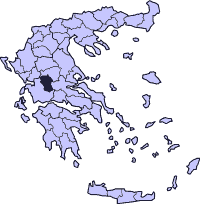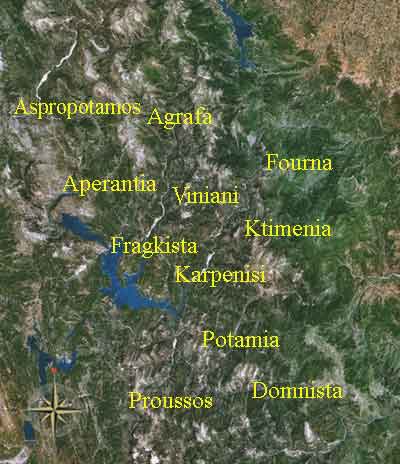|
|
Agrafa is a mountainous region in Evrytania, Thessaly in mainland Greece. It is mainly comprised of small villages, including Krioneri, Morfovouni (Vounesi), and others. The Agrafa is famous for its completely autonomy throughout the entire 400 years of Ottoman Turkish occupation of Greece and the Balkans. The word agrafa literally translates to "unwritten." Because the Turks were unable to conquer this region, the area and its population were not recorded in the Sultan's tax register. As a result the people were free to conduct their business and their customs as they pleased without Ottoman influence. The Agrafa region has been populated for approximately 2,500 years. The fiercely independent spirit of its people, known as Agrafiotes, is matched by a harsh and forbidding landscape. The central Agrafiotis River valley is surrounded on three sides by a steep 2,000-meter wall of mountains, and on its south side the river drains via a series of narrow and often impassable gorges into the man-made Lake Plastiras. Most of the surrounding forests in the region were controlled by Greek Orthodox monasteries for many hundreds of years and throughout the Turkish occupation of the Balkans. The residents of the Agrafa purchased tracts of land from the monasteries hundreds of years ago and these forests remain in the communal hands of the current inhabitants. Ironically, the Agrafa was a center of literacy during the 400 years of domination and slavery by the Turks. Since the monasteries were independent from the Sultan, it was here that the Greek language was kept alive; reading and writing were taught in secret generation after generation as the Turks forbid the general population to learn how to read and write their own language. Unlike the majority of Greeks many Agrafiotes can trace their family histories back for generations since they were free to read, write, and record births, baptisms, and deaths.
Modernization Before modernization, most people's occupations in the Agrafa involved harvesting nuts and fruits from orchards, farming, shepherding, and textile manufacturing. Most of the produce from the Agrafa are traditional cold weather crops or crops which can survive in poor soil. The beans grown in the Agrafa are second to none for flavor and quality. The proceeds of the timber sales from the forests purchased from the Greek Orthodox monasteries continue to benefit the community as a whole. The most famous person from the Agrafa and the driving force behind modernization was General Nikolaos Plastiras. It was General Plastiras' vision to create a hydroelectric dam in the region so that nearly all of mainland Greece, excluding the Peloponese, would be supplied with electricity, particularly the many fractured villages and rural communities. A spin-off from this project was the mass irrigation system developed to supply the farmers in the plains of Thessaly with water and increase the yields of cash crops such as cotton. Construction began during the peaceful era of the 1950s after World War II and the Greek Civil War. Once completed General Plastiras' hydroelectric dam propelled the Greek nation into the modern era. The majority of the workers on this project were Agrafiotes themselves. As a result of their years of dedication and sacrifice to the project, the residents of the region enjoy free water up until this day. The Agrafa, originally one of the poorest and most isolated regions of Greece, is quickly becoming a hot tourist destination, as the area's beauty is reminscent of the Alps of Austria and Switzerland. Many Agrafiotes left their villages and settled in the major metropolitan cities in Greece as well as in the United States, Canada, Australia, and Germany, seeking an escape from the abject poverty and lack of opportunities which once haunted the area. The migration from the region first began in the 1920s and has nearly ceased after the military junta which had ruled Greece from 1967-1974 was toppled.
 |
|||||||||||||||||






